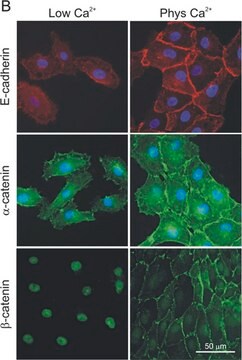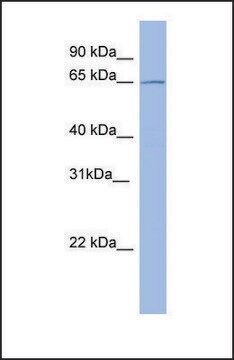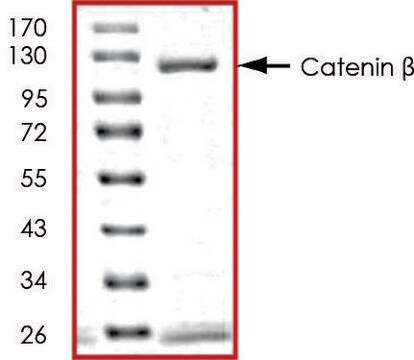SRP5171
Catenin α, GST tagged human
recombinant, expressed in baculovirus infected Sf9 cells, ≥70% (SDS-PAGE), buffered aqueous glycerol solution
Synonym(s):
CAP102, CTNNA1, FLJ36832
Sign Into View Organizational & Contract Pricing
All Photos(1)
About This Item
Recommended Products
biological source
human
recombinant
expressed in baculovirus infected Sf9 cells
Assay
≥70% (SDS-PAGE)
form
buffered aqueous glycerol solution
mol wt
~123 kDa
NCBI accession no.
application(s)
cell analysis
shipped in
dry ice
storage temp.
−70°C
Gene Information
human ... CTNNA1(1495)
General description
Catenin α is a novel actin-binding and -bundling protein. Catenin α is responsible for organizing and tethering actin filaments at the zones of E-cadherin-mediated cell-cell contact. Monomeric Catenin α can bind strongly to E-Cadherin-β-Catenin, whereas the dimer preferentially binds actin filaments. Different molecular conformations are associated with these different binding states, indicating that Catenin α is an allosteric protein. Catenin α directly regulates actin-filament organization by suppressing Arp2/3-mediated actin polymerization, likely by competing with the Arp2/3 complex for binding to actin filaments
Physical form
Supplied in 50mM Tris-HCl, pH 7.5, 150mM NaCl, 10mM glutathione, 0.1mM EDTA, 0.25mM DTT, 0.1mM PMSF, 25% glycerol.
Preparation Note
after opening, aliquot into smaller quantities and store at -70 °C. Avoid repeating handling and multiple freeze/thaw cycles
Storage Class Code
10 - Combustible liquids
WGK
WGK 1
Certificates of Analysis (COA)
Search for Certificates of Analysis (COA) by entering the products Lot/Batch Number. Lot and Batch Numbers can be found on a product’s label following the words ‘Lot’ or ‘Batch’.
Already Own This Product?
Find documentation for the products that you have recently purchased in the Document Library.
Frauke Drees et al.
Cell, 123(5), 903-915 (2005-12-06)
Epithelial cell-cell junctions, organized by adhesion proteins and the underlying actin cytoskeleton, are considered to be stable structures maintaining the structural integrity of tissues. Contrary to the idea that alpha-catenin links the adhesion protein E-cadherin through beta-catenin to the actin
D L Rimm et al.
Proceedings of the National Academy of Sciences of the United States of America, 92(19), 8813-8817 (1995-09-12)
Calcium-dependent homotypic cell-cell adhesion, mediated by molecules such as E-cadherin, guides the establishment of classical epithelial cell polarity and contributes to the control of migration, growth, and differentiation. These actions involve additional proteins, including alpha- and beta-catenin (or plakoglobin) and
Our team of scientists has experience in all areas of research including Life Science, Material Science, Chemical Synthesis, Chromatography, Analytical and many others.
Contact Technical Service







